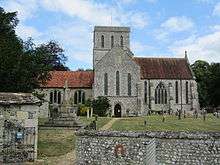
Amesbury Abbey
Amesbury Abbey was a Benedictine abbey at Amesbury in Wiltshire, founded by Queen Ælfthryth in about the year 979 on what may have been the site of an earlier monastery. The foundation was dissolved in 1177.
The abbey church has survived as the church of St Mary and St Melor, a Grade I listed building. The name Amesbury Abbey is now used by a nearby mansion, which has since been converted into a nursing home. This house is also a Grade I listed building.
History
Ælfthryth founded two religious houses at about the same time, the other being at Wherwell in Hampshire. Her motive was long believed to be contrition for the murder of Edward the Martyr, making the date of 979 given by the Melrose chronicle appropriate. However, she is now considered not to have been personally responsible for the murder.
Amesbury was already a sacred place in Pagan times, and there are legends that a monastery existed there before the Danish invasions. There may have been an existing cult of St Melor which led Ælfthryth to choose Amesbury. Melor, the son of a leader of Cornouaille and a boy-martyr, was buried at Lanmeur and venerated in Brittany, but a later tradition claims that some of his relics were brought to Amesbury and sold to the abbess. Edward was another boy-martyr. However, the 12th-century life of St Melor says the nunnery at Amesbury was founded before Melor's relics arrived. At the time of the Domesday Book (1086), the abbey held, as it had in King Edward's time, the Wiltshire manors of Bulford, Boscombe, Allentone, Choulston, and Maddington, totalling twenty-seven hides, plus the manor of Rabson in Winterbourne Bassett. In Berkshire it held Ceveslane in Challow, Fawley, and Kintbury and the church at Letcombe Regis.

Amesbury
Coordinates: 51°10′N 1°46′W / 51.17°N 1.77°W / 51.17; -1.77
Amesbury /ˈeɪmzbəri/ is a town and civil parish in Wiltshire, England. It is most famous for the prehistoric monument of Stonehenge which is in its parish, and for the discovery of the Amesbury Archer—dubbed the King of Stonehenge in the press—in 2002. It has been confirmed by archaeologists that it is the oldest continuously occupied settlement in the United Kingdom, having been first settled around 8820 BC.
Eleanor of Provence, queen of England, died in Amesbury on 24 or 25 June 1291, and was buried in Amesbury Abbey.
The parish includes the hamlets of Ratfyn and West Amesbury, and most of Boscombe Down military airfield.
Geography
Amesbury is located in southern Wiltshire, 7 miles (11 km) north of Salisbury on the A345. It sits in the River Avon valley on the southern fringes of Salisbury Plain and has historically been considered an important river crossing area on the road from London to Warminster and Exeter. This has continued into the present with the building of the A303 across the Avon next to the town. Originally the town developed around the water meadows next to several bends in the river, but in time has spread onto the valley hillsides and absorbed part of the military airfield at Boscombe Down.

Amesbury, Massachusetts
Amesbury is a city in Essex County, Massachusetts, located on the left bank of the Merrimack River near its mouth, upstream from Salisbury and across the river from Newburyport and West Newbury. The population was 16,283 at the 2010 census. A former farming and mill town, Amesbury is today largely residential. It is one of the two northernmost towns in Massachusetts (the other being neighboring Salisbury).
History
Settlement period
In 1637 the first English settler in the Salisbury-Amesbury region, John Bayly, crossed the Merrimack River from the new settlement at Newbury, built a log cabin, and began to clear the land for cultivation. He intended to send to England for his wife and children, but they never did rejoin him. He and his hired man, William Schooler, were arrested shortly for a murder Schooler had committed. The latter was hanged for it. Bayly was acquitted. Given the fishing rights on the river by the subsequent settlement, provided he would sell only to it, he abandoned agriculture for fishing.
Amesbury (disambiguation)
Amesbury is a town and civil parish in Wiltshire, England.
Amesbury may also refer to:
Places
- Amesbury (CDP), Massachusetts, a US census-designated place
Schools
- Amesbury High School, Amesbury, Massachusetts, US
- Amesbury Middle School, Amesbury, Massachusetts, US
People
Podcasts:

